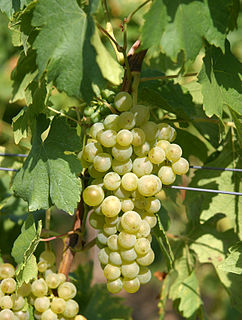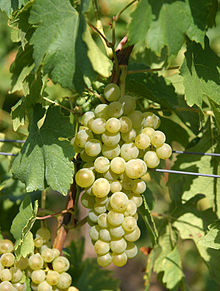
Riesling is a white grape variety that originated in the Rhine region. Riesling is an aromatic grape variety displaying flowery, almost perfumed, aromas as well as high acidity. It is used to make dry, semi-sweet, sweet, and sparkling white wines. Riesling wines are usually varietally pure and are seldom oaked. As of 2004, Riesling was estimated to be the world's 20th most grown variety at 48,700 hectares, but in terms of importance for quality wines, it is usually included in the "top three" white wine varieties together with Chardonnay and Sauvignon blanc. Riesling is a variety that is highly "terroir-expressive", meaning that the character of Riesling wines is greatly influenced by the wine's place of origin.
Rotberger is a wine grape variety. Its parentage is not known with certainty but it is thought to be from a cross of Trollinger and Riesling grapes. Dr. Heinrich Birk (1898-1973) produced the cross at the Geisenheim Grape Breeding Institute in 1928. It is used to produce fruity, early maturing light red wines in cool-climate areas. It is often best drunk when young and can be used to produce a rosé or sparkling wine. It has no relationship with the Rotburger variety bearing a nearly similar name which is also known as Zweigelt.

German wine is primarily produced in the west of Germany, along the river Rhine and its tributaries, with the oldest plantations going back to the Roman era. Approximately 60 percent of German wine is produced in the state of Rhineland-Palatinate, where 6 of the 13 regions (Anbaugebiete) for quality wine are situated. Germany has about 103,000 hectares of vineyard, which is around one tenth of the vineyard surface in Spain, France or Italy. The total wine production is usually around 10 million hectoliters annually, corresponding to 1.3 billion bottles, which places Germany as the eighth-largest wine-producing country in the world. White wine accounts for almost two thirds of the total production.

Müller-Thurgau is a white grape variety which was created by Hermann Müller from the Swiss Canton of Thurgau in 1882 at the Geisenheim Grape Breeding Institute in Germany. It is a crossing of Riesling with Madeleine Royale. It is used to make white wine in Germany, Austria, Northern Italy, Hungary, England, Australia, the Czech Republic, Slovakia, Slovenia, New Zealand, Canada, the United States, Belgium and Japan. There are around 22,201 hectares ) cultivated worldwide, which makes Müller-Thurgau the most widely planted of the so-called "new breeds" of grape varieties created since the late 19th century. Although plantings have decreased significantly since the 1980s, as of 2019 it was still Germany's second most planted variety at 11,400 hectares and 11.4% of the total vineyard surface. In 2007, the 125th anniversary was celebrated at the Geisenheim Grape Breeding Institute. Müller-Thurgau is also known as Rivaner, Riesling x Sylvaner, Riesling-Sylvaner, Rizvanec (Slovenia) and Rizlingszilváni (Hungary).

Scheurebe or Sämling 88 is a white wine grape variety. It is primarily grown in Germany and Austria, where it often is called Sämling 88, and some parts of the New World. Scheurebe wines are highly aromatic, and the variety is often used for sweet wines, although dry Scheurebe wines have become more common in Germany.

Hermann Müller, was a Swiss botanist, plant physiologist, oenologist and grape breeder. He called himself Müller-Thurgau, taking the name of his home canton.

Rondo is a dark-skinned grape variety, used for making red wine. It is a hybrid grape or inter-specific crossing. It was created in 1964 by Professor Vilém Kraus in then-Czechoslovakia by crossing the varieties Zarya Severa and St. Laurent. He offered it to Dr. Helmut Becker (1927-1990) of the Geisenheim Grape Breeding Institute who conducted further work on it, which explains why the grape is known under a Geisenheim designation. The variety was first planted for research and later in bigger scale in the mid 1980s by Thomas Walk Vineyard in Ireland under the name Amurensis Walk; it was named Rondo in 1997.

Eberbach Abbey is a former Cistercian monastery in Eltville in the Rheingau, Germany. On account of its Romanesque and early Gothic buildings it is considered one of the most significant architectural heritage sites in Hesse.

The Geisenheim Grape Breeding Institute was founded in 1872 and is located in the town of Geisenheim, in Germany's Rheingau region. In 1876 Swiss-born professor Hermann Müller joined the institute, where he developed his namesake grape variety Müller-Thurgau, which became Germany's most-planted grape variety in the 1970s. Professor Helmut Becker worked at the institute from 1964 until his death in 1989.
Breidecker is white variety of grape. It is a hybrid grape, an interspecific crossing × Seibel 7053. It can be used to make a German style light white wine with apple and pear flavors. "This cultivar was released by the Geisenheim Research Station, Germany, in 1962. Has the technical name GM 4894. It was derived from a Müller-Thurgau cross with the Chancellor hybrid cultivar and can currently be found in limited areas in the South Island of New Zealand, where it is mainly used for producing somewhat neutral varietal and blend white wines. Resistant to bunch rot and downy mildew fungus diseases. Breidecker was named after Heinrich Breidecker, one of New Zealand pioneer grape growers."

Ehrenfelser is a white wine grape variety of German origin. It was created by Dr. Heinrich Birk (1898-1973) at the Geisenheim Grape Breeding Institute in 1929, by crossing Riesling with what was thought at the time to be Silvaner, but DNA markers have since indicated it was the Alsace variety Knipperlé.

The Kerner grape is an aromatic white grape variety. It was bred in 1929 by August Herold by crossing Trollinger and Riesling. Herold was working at a plant breeding station in Lauffen in the Württemberg region of Germany. This station belonged to a state breeding institute headquartered in Weinsberg. It received varietal protection and was released for general cultivation in 1969.

Orléans is a variety of white grape which up until the 19th century was much grown in Germany, but in very little use since the early 20th century. It has large berries with thick skins and a high yield. Young Orléans wine has been described as somewhat reminiscent of wine made from white varieties of the pinot family, but with pineapple aromas.

Solaris is a variety of grape used for white wine. It was created in 1975 at the grape breeding institute in Freiburg, Germany by Norbert Becker.
Optima is a white wine grape that was created by viticulturalist Peter Morio at the Geilweilerhof Institute for Grape Breeding in the Palatinate in 1930. Morio crossed a Riesling x Silvaner cross with Müller-Thurgau. The Riesling x Silvaner is sometimes mentioned as Rieslaner, but more often just as "a Riesling x Silvaner". Due to the random element of genetic recombination involved in sexual reproduction of plants, no two crosses of the same parent grape varieties will be identical, so there is a difference between the Riesling x Silvaner cross Rieslaner, and each other such cross.

Ehrenbreitsteiner is a white wine grape variety of German origin. It was created by Helmut Becker at the Geisenheim Grape Breeding Institute in 1964, by crossing the varieties Ehrenfelser and Reichensteiner. It was granted plant variety rights in 1993 and was certified in 1994.

Pinot Noir Précoce or, as it is called in parts of Germany, Frühburgunder is a dark, blue-black–skinned, variety of grape used for wine and is a form or mutation of Pinot noir, which differs essentially by ripening earlier than normal. Whilst sometimes treated as a separate grape variety by ampelographers, there are nevertheless those who consider it is simply an early ripening form of Pinot Noir, and in some cases, Pinot Noir Précoce wines may therefore be found straightforwardly labelled "Pinot noir".

Olmo grapes are wine and table grape varieties produced by University of California, Davis viticulturist Dr. Harold Olmo. Over the course of his nearly 50-year career, Dr. Olmo bred a wide variety of both grapes by means of both crossing varieties from the same species or creating hybrid grapes from cultivars of different Vitis species.

Heinrich Birk was a German viticulturist. He was head of the Geisenheim Grape Breeding Institute. Heinrich Birk studied philosophy at the University of Giessen after his initial graduation 1920–1923 in agronomy at the university of Bonn and after 1924 in addition to an initial position on the domain Steinberg, Kloster Eberbach. He received his doctorate in this subject in 1929. At this time he was already two years as clerk at the Geisenheim Research Center at the Institute of vines finishing as an assistant to Professor F. Muth. 1939 he became head of the Reichs-Rebenzuchtstation. He had to quit a year later because of his compulsory military service. 1945 Birk returned and devoted himself in postwar reconstruction.
Hibernal is a variety of white wine grape of the hybrid with Vitis vinifera which was developed in 1944, by Heinrich Birk at the Geisenheim Grape Breeding Institute. The variety is a genetic crossbreed of the Seibel 7053 and Riesling clone 239 grape varieties. Hibernal has had plant variety protection since 1977 and was included on the list of varieties in 1999.
















